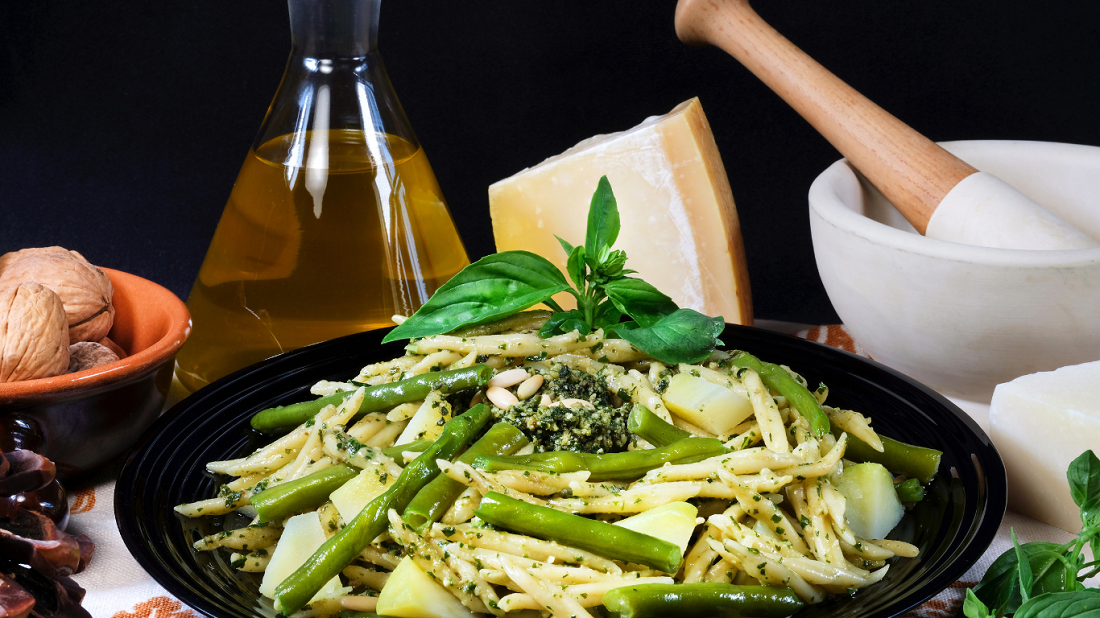Introduction.
Italian cuisine is renowned for its rich flavors, regional diversity, and the artistry of its dishes. Among the gems of Italian culinary tradition is trofie pasta, a unique shape that hails from the Liguria region, particularly associated with the coastal city of Genoa. This traditional pasta is often paired with Genovese pesto, a vibrant and aromatic sauce made from fresh basil, pine nuts, garlic, Parmesan cheese, and olive oil. In this article, we will delve into the history, preparation, and cultural significance of trofie pasta with Genovese pesto, while exploring its place in Italian culinary heritage.
The Origins of Trofie Pasta.
A Historical Perspective.
Trofie pasta has its roots in the Ligurian countryside, where it was traditionally made by hand. The name “trofie” is believed to derive from the Genoese dialect word “strufuggia,” which means to rub or twist. This refers to the method of shaping the pasta by rolling small pieces of dough against a flat surface to create elongated spirals. The pasta is typically made with just two ingredients: wheat flour and water, resulting in a simple yet delicious flavor that complements the sauce seamlessly.
The Cultural Significance.
In Liguria, trofie is more than just a type of pasta; it is a symbol of regional pride and identity. The dish has been prepared for generations, often served during family gatherings and festive occasions. The unique shape of trofie allows it to hold sauces exceptionally well, making it a favorite among locals and visitors alike.
Genovese Pesto: The Heart of the Dish.
The Origins of Pesto.
Pesto, or “pesto alla Genovese,” is a classic Italian sauce that originated in Genoa. The word “pesto” comes from the Italian term “pestare,” which means to crush or grind. This refers to the traditional method of preparing the sauce using a mortar and pestle, where fresh ingredients are ground together to create a fragrant paste.
Ingredients and Preparation.
The key ingredients of Genovese pesto include:
- Fresh Basil: The star ingredient of the sauce, fresh basil gives pesto its vibrant green color and aromatic flavor.
- Pine Nuts: These add a rich, buttery texture and a slightly sweet flavor.
- Garlic: A staple in Italian cooking, garlic provides a pungent kick to the sauce.
- Parmesan Cheese: Traditionally, aged Parmigiano Reggiano is used, imparting a nutty and savory depth to the pesto.
- Olive Oil: Extra virgin olive oil is essential for emulsifying the sauce and enhancing its richness.
The preparation process involves gently crushing the basil, garlic, and pine nuts to create a paste, then gradually adding the olive oil while mixing until a smooth consistency is achieved. Finally, grated Parmesan cheese is folded in to complete the sauce.
Variations of Pesto.
While the classic Genovese pesto is the most famous, there are numerous regional variations throughout Italy. For example, in Sicily, you might find pesto made with tomatoes and almonds, while in the southern regions, it may include more robust flavors such as sun dried tomatoes or chili peppers. However, the traditional Genovese pesto remains a beloved favorite and is often regarded as the quintessential Italian sauce.
Preparing Trofie Pasta with Genovese Pesto.
Ingredients for Trofie Pasta.
To prepare traditional trofie pasta with Genovese pesto, you will need the following ingredients:
For the Trofie:
- 2 cups of all purpose flour (or semolina flour)
- ½ cup of water
- A pinch of salt
For the Genovese Pesto:
- 2 cups of fresh basil leaves, packed
- ½ cup of pine nuts
- 2–3 cloves of garlic (to taste)
- ½ cup of grated Parmigiano Reggiano cheese
- ½ cup of extra virgin olive oil
- Salt to taste
Step by Step Preparation.
Making the Trofie Pasta.
- Prepare the Dough: In a mixing bowl, combine the flour and salt. Gradually add the water while mixing until a dough forms. Knead the dough on a floured surface for about 10 minutes until it becomes smooth and elastic.
- Rest the Dough: Wrap the dough in plastic wrap and let it rest for at least 30 minutes. This allows the gluten to relax, making it easier to shape the pasta.
- Shape the Trofie: Divide the rested dough into small pieces (about the size of a walnut). Roll each piece into a thin rope, about 1/4 inch thick. Cut the ropes into small pieces (around 1 inch long) and then roll each piece against a wooden board or your palm to create the characteristic twisted shape.
- Cook the Trofie: Bring a pot of salted water to a boil. Add the trofie pasta and cook for about 3-5 minutes until al dente. Fresh pasta cooks much faster than dried pasta, so keep a close eye on it.
Making the Genovese Pesto.
- Prepare the Ingredients: Rinse the basil leaves and pat them dry. Peel the garlic cloves.
- Blend the Pesto: In a mortar and pestle or food processor, combine the basil leaves, garlic, and pine nuts. Crush or pulse until a coarse paste forms.
- Add Olive Oil: Gradually drizzle in the olive oil while mixing until the pesto is smooth and well combined.
- Incorporate the Cheese: Fold in the grated Parmigiano Reggiano and season with salt to taste. Adjust the consistency by adding more olive oil if necessary.
Combining Trofie and Pesto.
Once the trofie pasta is cooked, reserve a small cup of the pasta cooking water. Drain the pasta and return it to the pot. Add the prepared Genovese pesto and a splash of the reserved pasta water to help emulsify the sauce. Toss the pasta until it is well coated with the pesto. Serve immediately, garnished with additional grated cheese and a drizzle of olive oil if desired.
Pairing Suggestions.
Wine Pairings.
Trofie pasta with Genovese pesto pairs beautifully with a variety of wines. A crisp white wine, such as a Vermentino or a Ligurian Pigato, complements the fresh flavors of the basil and the nuttiness of the pine nuts. Alternatively, a light bodied red wine like a Chianti can also work well, bringing out the richness of the dish.
Side Dishes.
For a complete Italian meal, consider serving the trofie with a light arugula salad dressed with lemon and olive oil. The peppery notes of arugula contrast nicely with the richness of the pesto. Additionally, a simple bruschetta topped with fresh tomatoes, basil, and balsamic glaze can make for a delightful appetizer.
The Cultural Impact of Trofie and Pesto.
Culinary Traditions.
Trofie pasta with Genovese pesto embodies the essence of Italian cooking simple ingredients transformed into something extraordinary. It reflects the Italian philosophy of using fresh, high-quality ingredients to create dishes that celebrate regional flavors.
Global Recognition.
In recent years, the popularity of Italian cuisine has surged worldwide, and dishes like trofie with pesto have gained recognition beyond Italy. Many Italian restaurants and home cooks globally have embraced this dish, making it a staple on menus and in kitchens alike.
Sustainability and Local Sourcing.
The emphasis on fresh, seasonal ingredients also aligns with contemporary trends in sustainability and local sourcing. Many chefs and home cooks prioritize using locally grown basil and organic produce, further enhancing the quality of the dish while supporting local farmers.
Conclusion.
Traditional trofie pasta with Genovese pesto is more than just a meal; it is a celebration of Italian culinary heritage and the beauty of simplicity in cooking. With its unique shape and vibrant flavors, this dish captures the essence of Liguria and showcases the artistry of Italian cuisine. As you prepare and enjoy this delightful dish, you participate in a centuries old tradition that continues to bring people together around the table.
Questions and Answers.
Q1: What is trofie pasta, and how is it made?
A1: Trofie pasta is a traditional Ligurian pasta shape made from flour and water. It is shaped by rolling small pieces of dough against a surface to create twisted, elongated strands.
Q2: What are the key ingredients in Genovese pesto?
A2: The key ingredients in Genovese pesto include fresh basil, pine nuts, garlic, Parmesan cheese, and extra virgin olive oil.
Q3: How do you prepare trofie pasta with Genovese pesto?
A3: To prepare trofie with pesto, you first make the trofie pasta from flour and water, then cook it. For the pesto, blend basil, garlic, pine nuts, and olive oil, then combine it with the cooked trofie.
Q4: What wine pairs well with trofie pasta with pesto?
A4: A crisp white wine, such as Vermentino or Pigato, pairs well with trofie pasta and pesto. Light bodied red wines like Chianti can also complement the dish.
Q5: Why is trofie with pesto considered a symbol of Italian culinary tradition?
A5: Trofie with pesto represents Italian culinary tradition through its use of simple, high quality ingredients, regional significance, and the emphasis on fresh flavors. It reflects the Italian philosophy of celebrating local ingredients and cooking methods passed down through generations.

